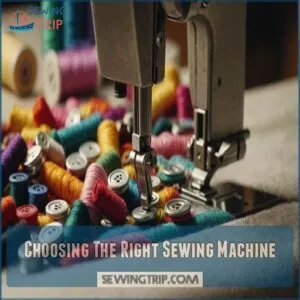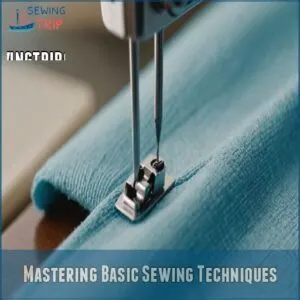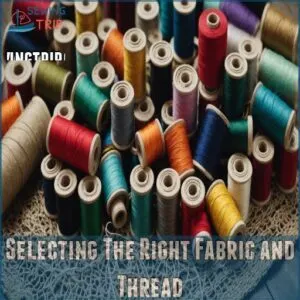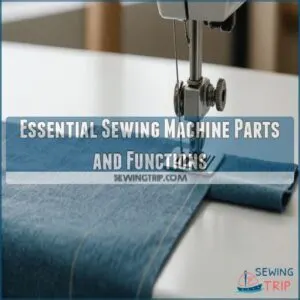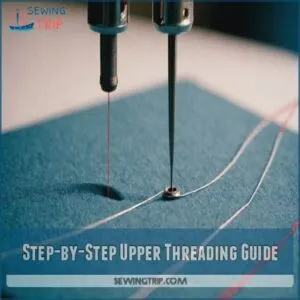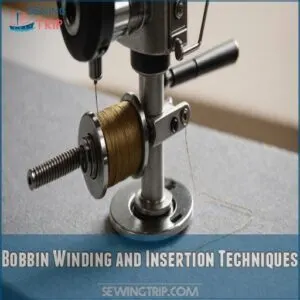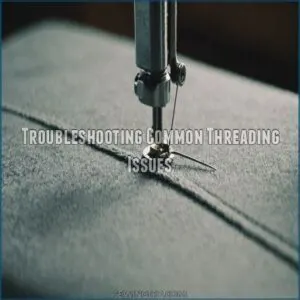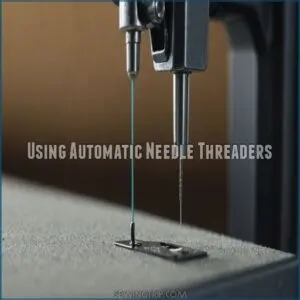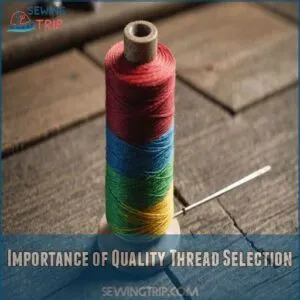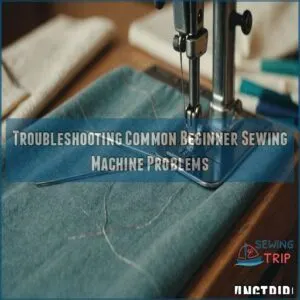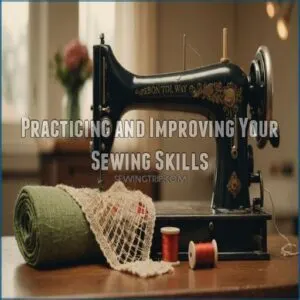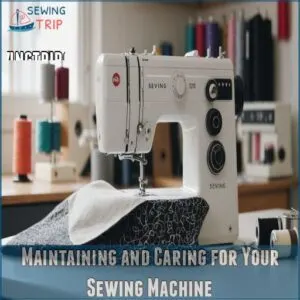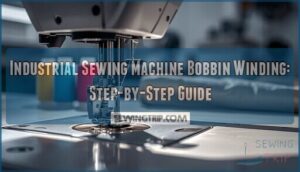This site is supported by our readers. We may earn a commission, at no cost to you, if you purchase through links.
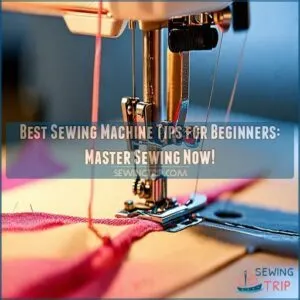 So you’re diving into sewing? Awesome!
So you’re diving into sewing? Awesome!
These best sewing machine tips for beginners will get you started.
First, choose a machine that fits your budget and skill level – don’t go overboard!
Matching threads are key; mismatched threads look like a toddler’s art project.
Keep those seams straight, practice makes perfect, and remember, even experienced sewers mess up sometimes.
Keep your workspace tidy; a clean space equals a clear mind.
Understanding your machine’s basic functions is essential.
Finally, don’t be afraid to experiment!
There’s more where that came from… you’ll soon be crafting masterpieces!
Table Of Contents
- Key Takeaways
- Choosing The Right Sewing Machine
- Setting Up Your Sewing Machine
- Mastering Basic Sewing Techniques
- Selecting The Right Fabric and Thread
- Essential Sewing Machine Parts and Functions
- Threading Your Machine Like a Pro
- Troubleshooting Common Beginner Sewing Machine Problems
- Practicing and Improving Your Sewing Skills
- Maintaining and Caring for Your Sewing Machine
- Frequently Asked Questions (FAQs)
- Conclusion
Key Takeaways
- When choosing a sewing machine, consider the type of projects you’ll be working on and the features you need, such as automatic needle threader and walking foot found in top sewing machines reviewed best sewing machines reviewed; don’t overspend. Focus on essential features like an automatic needle threader, speed control, and built-in light for a smoother experience.
- Keep your workspace tidy and understand your machine’s functions. This clarity helps you stay organized and efficient, making sewing enjoyable.
- Practice keeping seams straight and choose matching threads for clean, professional-looking projects. Regular practice improves your skills and builds confidence.
- Join sewing communities and use online tutorials to learn and get inspired. Setting realistic goals will help you improve progressively and stay motivated.
Choosing The Right Sewing Machine
Selecting the right sewing machine can feel like choosing your perfect pair of jeans—comfort and style matter, but so does functionality.
Consider what features you need, whether you’re eyeing a mechanical model or a fancy computerized one.
There are budget-friendly options and user-friendly brands ready to fit your sewing aspirations.
Key Features to Look For
When choosing a sewing machine for beginners, prioritize features like an automatic needle threader, speed control, and a built-in light.
These make your sewing experience smoother and more enjoyable.
A free arm is perfect for sewing sleeves and cuffs.
Don’t forget stitch types—having various options helps you tackle different projects confidently.
Embrace these sewing machine basics for seamless creativity!
Budget-Friendly Options
Curious about snagging a sewing machine without breaking the bank? Affordable options are plentiful!
Consider these savvy choices:
- Used sewing machines: Scoop up a bargain from local second-hand stores.
- Beginner kits: These often include all your basics.
- Affordable brands: Reliable models at a friendlier price.
- DIY upgrades: Customize an older machine with simple tweaks.
Find your perfect fit and start stitching!
Mechanical Vs. Computerized Machines
So, you’ve got your budget in mind, but should you go mechanical or computerized?
Mechanical sewing machines offer durability and a simple user experience, perfect for beginners mastering sewing basics, especially when paired with a user-friendly sewing machine for kids best sewing machine for a 10 year old, which can help young sewers develop their skills. Mechanical sewing machines offer durability and a simple user experience, perfect for beginners mastering sewing basics.
Computerized machines come with advanced features, yet they can have a steep learning curve and higher price.
Consider what suits your style—precision with buttons or classic control with dials.
Brands Known for User-Friendly Models
Simplicity is key when you’re choosing a sewing machine.
Top brands known for user-friendly models make your start a breeze.
Consider these beginner-friendly giants:
- Brother: Offers easy-to-use, reliable machines.
- Singer: Renowned for intuitive and durable models.
- Janome: Features straightforward instructions perfect for novices.
These brands make mastering sewing basics feel like a stroll, not a mountain climb.
Testing Machines Before Purchase
Ever been misled by a shiny gadget?
When testing sewing machines, don’t just buy on a whim.
Give those features a test drive and see them in action!
Check customer reviews, and compare brands like novice versus seasoned pros.
And remember, warranty check is key.
Here’s a quick guide:
| Tip | Why It Matters |
|---|---|
| Trial Run | See it in action! |
| Brand Comparison | Find best matches |
| Warranty Check | Peace of mind |
Setting Up Your Sewing Machine
Getting your sewing machine ready is easier than you think!
Let’s learn to identify the key parts, thread it correctly, and adjust the tension—it’s like assembling a fun, slightly complicated puzzle, and soon you’ll be sewing like a pro.
Locating and Understanding Machine Parts
Choosing the right sewing machine’s just the beginning; now, let’s locate and understand its parts.
Familiarize yourself with these:
- Power switch: Turns your machine on and off.
- Spool pin: Holds the thread spool.
- Presser foot: Holds fabric steady.
- Bobbin winder: Prepares your bobbin.
To get started with your machine, make sure to thread the needle and power up the machine following the manufacturer’s guidelines, which can be found in the sewing machine setup manual or online resources like how to set up sewing.
Knowing these parts helps tackle new projects confidently and keeps maintenance simple.
Choosing The Right Needle and Thread
Let’s talk needles and thread!
Picking the right needle types and thread weight can be a game-changer.
Match your sewing machine needles to fabric types—like pairing cotton threads with natural fibers.
Pay attention to thread tension and sewing machine settings for smooth progress.
Always aim for matching colors in sewing threads to complement your fabric perfectly.
Threading The Machine Correctly
Now that you’ve got the right needle and thread, threading your machine correctly is a breeze! First, follow the thread path from the spool pin to the needle’s eye.
Make sure:
- Thread is smooth: Avoid snags or tangles.
- Use the bobbin case: Keep it neat.
- Mind tension issues: Check threading.
- Consult tutorials: Find troubleshooting tips.
Ensuring Proper Thread Tension
Thread tension issues can unravel your sewing dreams quicker than a runaway spool!
Match your top and bobbin threads to avoid drama.
Adjust settings based on fabric type and keep calm with these basics:
| Troubleshooting Tips | Solutions |
|---|---|
| Loops on Back | Increase Top Tension |
| Loops on Top | Reduce Top Tension |
| Knotted Stitches | Check Bobbin Tension |
| Puckered Fabric | Match Thread/Fabric |
With practice, you’ll stitch like a pro!
Familiarizing Yourself With Machine Controls
Mastering the mystery of your sewing machine controls, especially with features like automatic needle threading, can feel like discovering a treasure chest of creativity.
Familiarize yourself with:
- Button Functions: Know what each does.
- Speed Control: Test your pedal sensitivity.
- Stitch Selection: Explore stitch varieties.
- Sewing Machine Manual: Your lifeline for troubleshooting and tips.
Once you’ve grasped these, sewing becomes a breeze!
Mastering Basic Sewing Techniques
You’re ready to master basic sewing techniques like straight stitching and turning corners, and it’s easier than you think with a bit of patience and practice when you invest in the right tools, such as high-quality sewing scissors, and practice simple techniques. You’re ready to master basic sewing techniques like straight stitching and turning corners, and it’s easier than you think with a bit of patience and practice.
Imagine the satisfaction of sewing in a straight line on your first try—it’s like finding the TV remote without even moving the sofa!
Straight Stitch and Backstitch
Two essential sewing basics are the straight stitch and backstitch.
The straight stitch creates your seams; the backstitch secures them, preventing unraveling.
It’s like adding a tiny knot at the beginning and end of your stitching.
Experiment with different stitch lengths – shorter stitches are stronger but slower.
Mastering these will improve your seam finishing techniques and give you more sewing machine control.
You’ll be amazed at how much a simple backstitch improves your projects!
Sewing in a Straight Line
You’ve got your straight stitch down, and now it’s time to cruise a straight line like a pro.
Focus on fabric alignment and needle position, using machine guides and controlling stitch length.
Keep your hand steady like a ship’s captain steering calm seas.
Remember, sewing machine classes can boost your skills and offer personalized sewing machine troubleshooting tips!
Turning Corners and Sewing Curves
When facing corners and curves in your sewing journey, imagine them like handling a winding road.
Slow down and keep your fabric tension consistent.
Use a shorter stitch length for smooth curves or sharp turns.
Maintain needle position down when adjusting.
A steady hand and presser foot control will guide you expertly, running through fabric like a sewing machine for kids!
Practicing on Spare Fabric
Juggling curves can feel like taming a wild beast, but practicing on spare fabric is your best ally.
Grab that leftover material, try different stitch lengths, and experiment with needle sizes.
Adjusting tension and preparing fabric type is where magic happens.
These sewing practice sessions will boost confidence and prepare you for simple sewing projects you’ll love tackling.
Troubleshooting Common Mistakes
Starting your sewing journey? Encountering puckered fabric or skipped stitches can feel like wrestling with a stubborn mule.
Check that sewing machine tension dial!
Skipped stitches might hide behind a dull needle or bobbin issues, so keep these on your radar.
Clean and oil your machine regularly.
Keep your sewing machine workspace tidy to prevent thread jams and promote sewing machine safety.
Selecting The Right Fabric and Thread
Choosing the right fabric and thread is like picking the perfect outfit for a party—it sets the tone for your entire project.
Stick with solid cottons for practice, and match your thread to the fabric type and color for great results.
Solid and Elastic Fabrics
You’ve mastered basic techniques; now let’s talk fabric. Choosing the right fabric makes a difference in your projects. Solid fabrics like cotton are beginner-friendly and stable, while elastic fabrics offer stretch for a challenge.
For achieving professional results, investing in a good sewing machine online store is essential.
Consider:
- Fabric types: cotton vs. jersey
- Sewing techniques: adjust tension dial
- Project ideas: pillows to leggings
- Fabric care: pre-wash fabrics
- Choosing patterns: match fabric and design
Choosing The Right Thread for Your Project
Now that you’ve picked your fabric, let’s talk thread!
Choosing the right thread is key.
Thread weight, type, and color all matter.
Matching thread to fabric is important for a professional look.
Here’s a handy guide:
| Thread Type | Weight | Color | Suitable Fabric |
|---|---|---|---|
| Cotton | Light | White | Cotton, linen |
| Polyester | Medium | Navy | Synthetics, blends |
| Silk | Light | Pastel Pink | Silk, delicate fabrics |
| Rayon | Medium | Black | Blends, knits |
| Heavy Duty | Heavy | Beige | Denim, canvas |
Experiment!
You’ll quickly master thread selection.
Pre-washing and Ironing Fabrics
Many sewing disasters come from ignoring pre-washing and ironing fabrics.
You’ve got to plan your sewing projects carefully, considering simple sewing machine projects for beginners like an elastic-waist skirt Simple Sewing Machine Projects, to beat fabric shrinkage before it ruins your sewing machine projects.
This is especially important for fabrics like flannel, where pre-washing flannel before sewing helps prevent distortion and shrinkage.
Here’s how:
- Pre-wash your fabric to stop color bleeding disasters.
- Use proper ironing tips to eliminate wrinkles.
- Master pressing techniques to prep fabrics perfectly.
Remember, neat preparation is your canvas for creativity!
Matching Thread Color to Fabric
After smoothing out those pre-washed fabrics, it’s time to play matchmaker between your thread colors and fabrics.
Embrace color theory basics and explore contrasting colors for striking effects.
Don’t shy away from matching prints or trying your hand at thread dyeing.
Remember, staying on top of color trends adds flair to any sewing project.
Keep your creations fresh and fashionable!
Considering Thread Weight and Type
Imagine this: You’re about to sew, and the thread weight and type matter big time.
A thread weight chart can be your best friend.
Here’s the scoop:
- Light fabrics? Opt for lightweight thread.
- Heavy materials? Go for a sturdier thread.
- Thread tension guide? Adjust for smooth sewing.
Your projects will never look better!
Essential Sewing Machine Parts and Functions
Understanding your sewing machine’s parts and functions is like meeting new friends who’ll be with you through thick and thin, or at least zigzag and straight stitch.
You’ll soon find that knowing these essentials makes your sewing journey smoother and way more fun!
Threading Mechanism
Feeling the fabric between your fingers, you’re ready to conquer the mysterious workings of a basic mechanical sewing machine, with its sturdy metal frame and adjustable settings that will help you master the threading mechanism.
Don’t let threading troubles trip you up; match your thread to your fabric, guide it from spool to needle, and keep an eye on tension issues.
It’s like threading a tiny labyrinth, but practice makes it second nature.
Bobbin and Bobbin Case
Threading the machine can be tricky, but once you’ve mastered that, let’s jump into bobbins.
A well-placed bobbin makes stitches neat—they’re like the unsung heroes of sewing!
Make sure bobbin winding is tight, adjust bobbin tension for smooth stitching, and learn your case types.
Troubleshooting bobbin placement issues will soon feel like second nature.
Sew on!
Presser Foot and Its Variations
The presser foot‘s your sewing sidekick! It holds fabric down while you stitch.
You’ll need a few types:
- A general-purpose foot for everyday sewing.
- A zipper foot for those tricky zippers.
- A buttonhole foot for perfectly-sized buttonholes.
- A walking foot for even feeding on multiple layers.
Proper foot selection is key; it’s like choosing the right tool for the job!
Regular cleaning keeps your presser foot in top shape.
Tension Dial and Adjustments
You’ve mastered the presser foot; now let’s talk tension.
Really, it’s a drama-free zone!
The tension dial is your trusty sidekick, determining how tight or loose your stitches hold.
Different fabrics and stitches might need a tweak or two.
Troubleshoot issues by fiddling with the dial—just like tuning a guitar until it sings sweetly!
Stitch Selection and Length Controls
Next on your sewing journey is understanding stitch selection and length controls.
Think of this as the heartbeat of your machine, guiding each needle move.
Explore varied stitch types for different fabric types.
To choose the best sewing machine for your needs, consider checking out top-rated models popular sewing machines online.
Play around:
- Adjust stitch length to suit your project.
- Experiment with decorative stitches for fun flair.
- Practice on scrap fabric to find your groove.
Threading Your Machine Like a Pro
You’ve mastered the challenge of taming tangled threads, setting the stage for smooth and seamless sewing adventures.
Threading your machine like a pro ensures your stitches are as tight and steady as your grandma’s favorite quilt.
Step-by-Step Upper Threading Guide
Ah, the ins and outs of threading your machine!
Start by placing your spool on the spool pin, and let’s conquer any threading challenges.
Guide the thread through the thread path, ensuring it’s snug but not too tight.
Needle threading might feel tricky at first, but with practice, you’ll master it.
Keep an eye on tension control for flawless stitches.
Bobbin Winding and Insertion Techniques
While winding your bobbin, make sure the thread tension is just right to prevent tangles.
Select the correct bobbin type for your machine—this isn’t a one-size-fits-all situation.
Insert it into the bobbin case smoothly, checking for compatibility.
If your bobbin winder acts up, a gentle nudge might help.
Consider this bobbin threading a key skill in mastering sewing.
Troubleshooting Common Threading Issues
Ever notice your thread tension‘s more chaotic than a toddler on sugar? It might be threading issues.
Make sure your bobbin winding’s neat and the thread matches your fabric type.
To prevent thread bunching up under fabric, check that the presser foot is down and set to the correct pressure, as explained in troubleshooting sewing machine problems.
Needle problems? Double-check it’s the right size.
If those loops and tangles still linger, a fresh pair of eyes – or hands – can help unravel the mystery.
Using Automatic Needle Threaders
With an automatic needle threader, threading your sewing machine becomes a breeze! Many machines offer these handy helpers. They save time and frustration.
- Less eye strain
- Fewer tangled threads
- Faster setup
Automatic threader types vary, but maintenance is usually simple.
If yours malfunctions, consider threader alternatives or professional help. You’ll be sewing like a pro in no time!
Importance of Quality Thread Selection
Reading your automatic needle threader manual can be a game-changer, but don’t overlook thread quality.
Picking the right thread means smooth sewing and fewer issues.
Look at the table below for a snapshot:
| Feature | Options | Tip Example |
|---|---|---|
| Thread Durability | Strong, Weak | Strong for heavy fabrics |
| Thread Color | Bright, Dark | Match or contrast creatively |
| Thread Weight | Light, Heavy | Light for delicate fabrics |
Choose wisely, and sewing will be a breeze!
Troubleshooting Common Beginner Sewing Machine Problems
As you begin your sewing journey, you’ll likely encounter mishaps like thread breakage, skipped stitches, and stubborn fabric jams—think of them as your sewing rite of passage.
Don’t worry, though; with a little patience and some handy troubleshooting tips, you’ll be back to creating masterpieces in no time, maybe even avoiding those awkward moments when your machine seems to have a mind of its own!
Dealing With Thread Breakage
Thread breakage got you down? Let’s fix that!
First, make sure you have proper thread tension. A familiar dance with tension dials could be the trick!
Second, check for needle compatibility—the wrong needle for the fabric type might snap your threads.
Third, improve your bobbin winding technique, keeping the thread type consistent.
Remember, sewing should feel like a seamless symphony, not a wrestling match!
Fixing Uneven or Skipped Stitches
Unravel skipped stitches by juggling these simple tweaks.
First, check your needle size; they’ve got to match the fabric type perfectly.
Is your bobbin playing hide and seek? Rewind it!
And don’t forget a quick machine cleaning to keep things smooth.
Often, these stitch snafus stem from basics overlooked, like fabric choice or neglected needle swaps.
Happy sewing!
Resolving Tension Issues
If you’re pulling your hair out over tension issues, you’re not alone.
Start by checking your thread tension settings and consider the thread quality and weight to make sure it matches your fabric type, as thread quality affects tension.
Adjust them if necessary, remembering that different materials like denim or silk require specific tension levels.
Make sure your needle and thread are compatible; mismatches can be problematic.
Finally, rewind the bobbin properly to prevent frustrating snarls.
Happy sewing!
Addressing Needle Breakage
Solving tension issues is a start, but what about needle breakage?
Choose the right needle type matching your fabric compatibility.
Check that needle size fits your project, and avoid rapid sewing speed, which can shatter even the strongest needle.
Regular machine maintenance keeps everything running smoothly.
Remember, it’s not you—it’s the tension between machine quirks and project ambition!
Handling Fabric Jams
Three common causes of fabric jams are: too much fabric under the needle, incorrectly threaded bobbin, or a clogged machine.
Preventative measures include checking your thread regularly and keeping your machine clean.
Removing jams? First, turn off your machine! Then:
- Gently lift the presser foot.
- Carefully remove the jammed fabric.
- Check your bobbin and rethread if needed.
Common solutions often involve simple fixes; you’ve got this!
Practicing and Improving Your Sewing Skills
Boost your sewing skills by exploring online tutorials and starting with simple projects to build confidence.
Joining sewing communities and setting realistic goals can make your sewing journey both enjoyable and rewarding.
Online Tutorials and Classes
Struggling with sewing glitches? Consider online tutorials and classes! They’re like having a sewing buddy at your fingertips.
Whether you’re sampling free resources or enrolled in paid courses, these learning platforms offer clear guidance.
They provide structure and community support while helping you tackle beginner projects with confidence. After all, even sewing ninjas started as novices!
Simple Projects for Beginners
You’re ready to explore your creativity with easy sewing projects at home!
Start small with these beginner-friendly ideas that boost your skills while crafting delightful items:
- Scrunchie: A fun accessory for any hairstyle.
- Tote bag: Perfect for daily essentials.
- Pillowcase: Adds a personal touch to your room.
- Hair bow: Cute and stylish.
- Apron: Great for kitchen endeavors.
Joining Sewing Communities
Imagine connecting with fellow sewing enthusiasts!
Joining sewing communities offers fantastic project inspiration.
From online sewing groups to local classes, these spaces encourage pattern sharing and fabric swaps.
Don’t underestimate the power of collective knowledge—it’s like having a sewing fairy godmother.
Here’s how to get started:
| Community Type | Benefits | Opportunities |
|---|---|---|
| Online Groups | Easy access, flexible | Pattern sharing |
| Local Classes | Hands-on guidance | Fabric exchanges |
| Meetups & Events | Networking, real-time | Project showcases |
Setting Realistic Goals and Challenges
Imagine this: You’ve got your sewing machine ready, perhaps one you found on a website for beginner sewing machines like Beginner Sewing Machines Online, and a mountain of beginner projects calling your name.
Start small to manage the learning curve.
Set realistic goals—like finishing a simple tote—one stitch at a time.
Embrace each challenge as a step in your skill progression.
Manage your time wisely; remember, Rome wasn’t sewn in a day!
Maintaining and Caring for Your Sewing Machine
Every sewing enthusiast knows the heartache of a misbehaving machine. To keep yours purring like a kitten, regular maintenance is key. Here’s a quick checklist:
- Cleaning: Dust and lint can bog down your gears. Wipe your machine gently after each project, and give it a thorough cleaning monthly.
- Lubrication: Like any well-oiled machine, your sewing buddy needs a little grease. Follow the manual’s instructions for lubrication points to avoid unnecessary wear.
- Storage: Store your machine in a dry, dust-free space. A cover can shield it from uninvited intruders like dust bunnies.
- Troubleshooting and Accessories: Keep spare needles, bobbins, and basic tools handy. A simple change often resolves many common glitches.
With these steps, you’ll extend your machine’s life and keep it ready for those creative bursts. Remember, a happy machine means a happy sewing experience!
Frequently Asked Questions (FAQs)
How to choose a sewing machine for beginners?
You’re standing in a sea of sewing machines, feeling overwhelmed.
Choose one with user-friendly controls, a variety of stitches, and adjustable settings.
Look for clear instructions and features that match your sewing goals.
Happy stitching!
How do you use a sewing machine?
Start by threading your machine, following the manual’s path from spool to needle.
Adjust tension for smooth stitches.
Practice on scrap fabric.
Use slow speeds initially.
Patience and practice turn sewing into a rewarding skill!
What should I know before starting a sewing machine?
Diving into sewing is like opening a treasure chest of creativity!
Familiarize yourself with machine parts, choose the right needle and thread, practice threading, and learn basic stitches.
It’s the start of endless crafting adventures.
How do you start a sewing machine?
Flip the power switch to bring your sewing machine to life.
Place your fabric under the presser foot.
Gently press the foot pedal to start sewing, keeping an eye on the needle and fabric alignment.
How to make a sewing machine faster?
Your sewing machine can zoom like a sprinter with these tweaks!
Adjust the foot pedal sensitivity, use the speed control button, and reduce tension settings.
Just remember, practice makes perfect—don’t sew off on a wild race!
How do I learn to sew on a sewing machine?
Start with simple stitches, practice threading, and don’t be afraid to make mistakes! You’ll master it with patience and practice. Lots of online tutorials can help you along the way!
What is the first thing a beginner should sew?
Consider sewing a simple pillowcase as your first project.
It’s a fantastic way to get comfy with straight stitches and sewing machine basics.
Plus, it’s useful, and you get a cozy reward for your efforts!
How to get better at using a sewing machine?
Experiment with different fabrics and settings; it’s like discovering a new level in a game.
Practice regularly, focusing on straight stitches, adjusting tension, and exploring various stitches.
Remember, even mistakes are part of mastering sewing.
Have fun!
What is the easiest thing to sew on a sewing machine?
Picture yourself creating a simple pillowcase—it’s like painting on a blank canvas.
You just need straight stitches, giving you the perfect playground to master basic techniques while crafting something comforting and functional for your home.
Can I teach myself to use a sewing machine?
You can definitely teach yourself to use a sewing machine!
With some patience, online tutorials, and practice, you’ll soon be sewing like a pro.
Mistakes will happen, but they’re just stitches on the path to mastery!
How do I store sewing supplies safely?
Who knew organizing fabric could rival a puzzle?
Store sewing supplies in clear bins for easy access, and use labeled jars for buttons and threads.
Hang scissors and rulers on a pegboard to avoid losing them.
What are budget-friendly sewing tools for beginners?
Grabbing a quality seam ripper, affordable fabric shears, and a starter sewing kit with pins, needles, and a tape measure can set you up nicely.
Add a simple pin cushion, and you’re ready to tackle projects economically!
How can I personalize sewing projects easily?
Experiment with fun fabrics! Add patches, embroidery, or unique buttons. Don’t be afraid to mix patterns; let your creativity shine! It’s your project, make it uniquely yours.
Which patterns are easiest for beginners?
Starting simple, picture yourself crafting an apron or pillowcase – these patterns are beginner-friendly.
They offer straightforward steps, minimal pieces, and a chance to practice basic skills without getting tangled in complex instructions.
How do I measure fabric accurately?
Measuring fabric accurately is a breeze with a trusty tape measure and a flat surface.
Spread your fabric smoothly, avoiding wrinkles.
Make sure your tape measure is straight, and double-check your measurements for precision.
Happy sewing!
Conclusion
Think of sewing as a journey, like learning to drive; the road can be bumpy, but the destination is rewarding.
By absorbing these best sewing machine tips for beginners, you’re set to conquer sewing like a pro.
Start with the right equipment, practice basic stitches, and tackle issues with confidence.
Embrace mistakes—they’re just detours on the path to creativity.
Pretty soon, you’ll craft stunning projects, growing your skills with each thread you weave.
Happy sewing adventures await!

